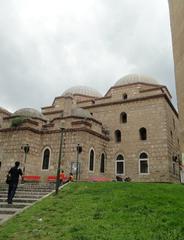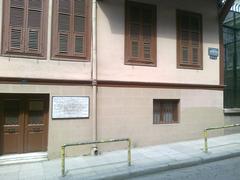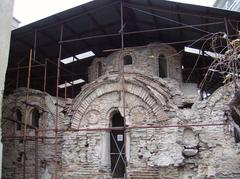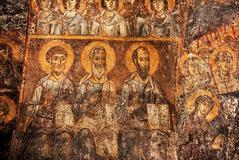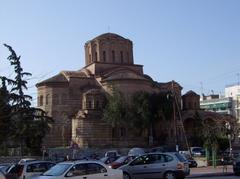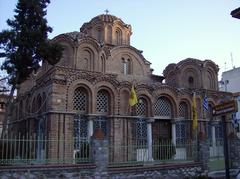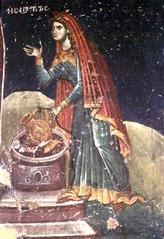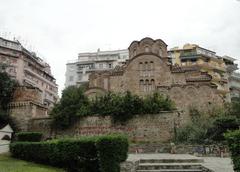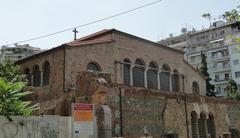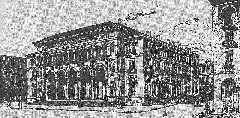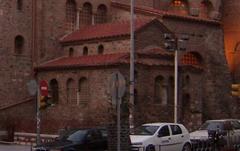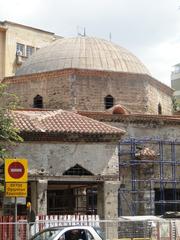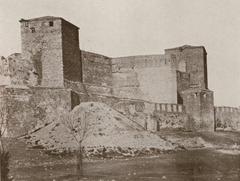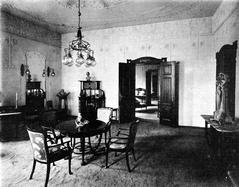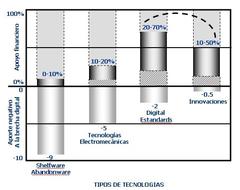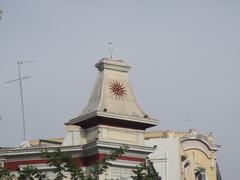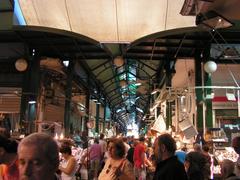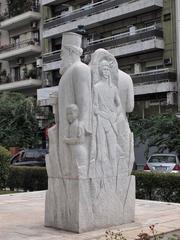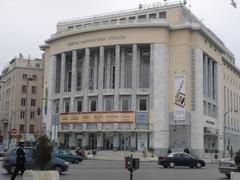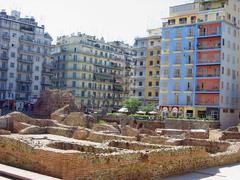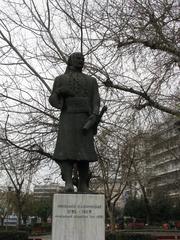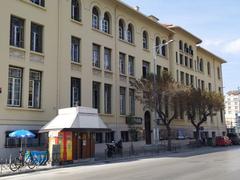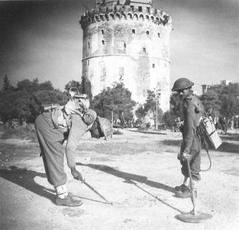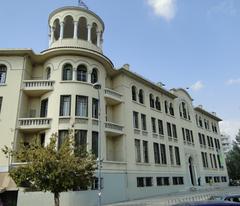Visiting Hours, Tickets, and Historical Sites of Αψίδα Γαλερίου (Καμάρα), Thessaloniki, Greece
Publication Date: 17/07/2024
Introduction to Αψίδα Γαλερίου (Καμάρα)
Nestled in the heart of Thessaloniki, Greece, the Arch of Galerius, locally known as Kamara, stands as an enduring symbol of the grandeur of Roman architecture and urban planning. Constructed in 298-299 AD, this monumental structure was built to commemorate Roman Emperor Galerius’s victory over the Sassanid Persians and the capture of their capital, Ctesiphon. The Arch of Galerius is not just a historical artifact but a living testament to the artistic and cultural achievements of the late Roman Empire. The arch, adorned with intricate reliefs depicting scenes from Galerius’s military campaigns, his triumphal procession, and various deities, serves as both a historical document and a monumental piece of propaganda (Ancient History Encyclopedia). Over centuries, the arch has witnessed numerous historical transformations, from the Byzantine period through the Ottoman era to modern times. Today, it remains a focal point in Thessaloniki, drawing visitors from around the world who come to marvel at its architectural beauty and historical significance (Thessaloniki Tourism Organization). This guide aims to provide a comprehensive overview of the Arch of Galerius, including its historical background, architectural significance, visitor information, and travel tips, ensuring a memorable and educational experience for all who visit.
Table of Contents
- Introduction
- Historical Background
- Later History and Preservation
- Modern Significance
- Visiting Hours and Tickets
- Travel Tips and Nearby Attractions
- Archaeological Research
- Visitor Experience
- FAQ
- Conclusion
Historical Background
Construction and Purpose
The Αψίδα Γαλερίου, commonly known as the Arch of Galerius or Kamara, is a significant historical monument located in Thessaloniki, Greece. It was constructed in 298-299 AD to commemorate the Roman Emperor Galerius’s victory over the Sassanid Persians and the capture of their capital, Ctesiphon, in 298 AD. The arch was part of a larger complex that included the Rotunda, a mausoleum for Galerius, and a palace complex, reflecting the grandeur of Roman architecture and urban planning (UNESCO).
Architectural Design
The arch originally consisted of a central archway flanked by two smaller side arches, creating a triple-arched structure. The central archway, which still stands today, was approximately 12.5 meters high and 10 meters wide. The entire structure was adorned with intricate reliefs depicting scenes from Galerius’s military campaigns, his triumphal procession, and various deities, symbolizing the emperor’s divine favor and military prowess (Ancient History Encyclopedia).
Reliefs and Iconography
The reliefs on the arch are a testament to the artistic and cultural achievements of the late Roman Empire. They are divided into several panels, each narrating a different aspect of Galerius’s victories and his role as a ruler. One of the most notable panels depicts the emperor on horseback, leading his troops into battle, while another shows him receiving the submission of the Persian king. These reliefs not only celebrate Galerius’s military success but also serve as propaganda, reinforcing his legitimacy and divine right to rule (Livius).
Historical Context
The construction of the Arch of Galerius must be understood within the broader context of the Tetrarchy, a system of government established by Emperor Diocletian in 293 AD to address the administrative and military challenges facing the Roman Empire. Galerius was appointed as one of the four rulers (Caesars) under this system, and his victories were crucial in securing the eastern borders of the empire. The arch, therefore, not only commemorates a specific military victory but also symbolizes the stability and unity brought about by the Tetrarchic system (Oxford Classical Dictionary).
Later History and Preservation
Over the centuries, the Arch of Galerius has witnessed numerous historical events and transformations. During the Byzantine period, Thessaloniki became an important center of Christianity, and the arch’s pagan iconography was largely ignored. However, the structure itself remained intact and continued to be a prominent landmark in the city. In the Ottoman period, the arch suffered some damage, but it was not until the 20th century that significant restoration efforts were undertaken to preserve this historical monument (Thessaloniki Tourism Organization).
Modern Significance
Today, the Arch of Galerius stands as a symbol of Thessaloniki’s rich historical and cultural heritage. It is a popular tourist attraction, drawing visitors from around the world who come to admire its architectural beauty and historical significance. The arch is also a focal point for various cultural events and activities, reflecting its enduring importance in the life of the city (Visit Greece).
Visiting Hours and Tickets
The Arch of Galerius is open to the public year-round, and there is no admission fee to view the monument. However, nearby attractions such as the Rotunda may have specific visiting hours and ticket prices. It is advisable to check the Thessaloniki Tourism Organization’s website for the most up-to-date information on visiting hours and ticketing (Thessaloniki Tourism Organization).
Travel Tips and Nearby Attractions
Accessibility
The site is easily accessible and located in the center of Thessaloniki, making it a convenient stop for tourists.
Nearby Attractions
Don’t miss the nearby Rotunda, the ancient Roman Forum, and the Byzantine Walls, which offer a comprehensive view of Thessaloniki’s historical layers.
Guided Tours
Consider joining a guided tour to gain deeper insights into the historical and cultural significance of the arch and other nearby monuments.
Archaeological Research
Ongoing archaeological research continues to shed light on the construction techniques and historical context of the Arch of Galerius. Recent studies have focused on the materials used in the construction, the methods employed by Roman engineers, and the iconographic program of the reliefs. These research efforts are crucial for understanding the monument’s place within the broader framework of Roman art and architecture (Journal of Roman Archaeology).
Visitor Experience
For visitors, the Arch of Galerius offers a unique opportunity to step back in time and explore the rich history of Thessaloniki. Informational plaques and guided tours provide valuable insights into the historical and cultural significance of the arch, enhancing the visitor experience. Additionally, the nearby Rotunda and other historical sites offer a comprehensive view of the Roman and Byzantine heritage of Thessaloniki (Thessaloniki Travel Guide).
FAQ
Q: What are the visiting hours for the Arch of Galerius?
A: The Arch of Galerius is open to the public 24/7, while nearby attractions may have specific visiting hours.
Q: Is there an admission fee to visit the Arch of Galerius?
A: No, there is no admission fee to view the Arch of Galerius.
Q: Are guided tours available?
A: Yes, guided tours are available and recommended for a deeper understanding of the site’s historical and cultural significance.
Q: What other historical sites are nearby?
A: Nearby historical sites include the Rotunda, the ancient Roman Forum, and the Byzantine Walls.
Conclusion
The Arch of Galerius, or Kamara, is more than just a relic of the past; it is a historical narrative carved in stone, offering a glimpse into the Roman Empire’s grandeur and the legacy of one of its most significant emperors. From its initial construction to commemorate Emperor Galerius’s victory over the Sassanid Persians to its role as a cultural and historical landmark in modern Thessaloniki, the arch stands as a testament to the city’s rich and diverse heritage. Its intricate reliefs, architectural design, and enduring presence make it an invaluable educational resource and a key attraction for tourists. Ongoing preservation efforts and archaeological research ensure that the Arch of Galerius will continue to educate and inspire future generations. For those planning a visit, the arch’s central location, accessibility, and the wealth of nearby historical sites make it a must-see destination. Whether you are a history enthusiast, a casual traveler, or a scholar, the Arch of Galerius offers a unique opportunity to step back in time and explore the rich tapestry of Thessaloniki’s past (Visit Greece).
